|
27th
October.
White Sands and Barns
Ness
A high pressure was firmly stationed over the UK meaning bright but cold
weather was assured, for Sunday at least, so we returned to the area
east of Dunbar that has always been a fertile source of sightings,
Barns Ness and White Sands. Our usual breakfasts in Dalkeith was
Morrisons Cafe was slightly disappointing as the bacon and tattie
scones were overdone, hence 8/10. Also the Cafe has been extended
leading to the removal of the four comfy armchairs we preferred. We
started our quest on the approach road to White Sands where we saw a
pair of Buzzards circling over the woods on the left (see
“Pictures of the Week”, below). John took control
of my
Nikon D500 and fired a few shots from the car. After parking we made our
way onto the sands where we found the wind was rather brisk and
cutting. But at the west end of the shore we came across an area of
seaweed-strewn beach where a variety of birds were vigorously feeding.
Scandinavian Rock pipits were closest, and, gathered on the
sea
close to the seaweed, were a large number of gulls, mainly Herring and
Black-headed Gulls.
| Common Buzzard |
|
Scandinavian Rock Pipit |
Herring Gull |
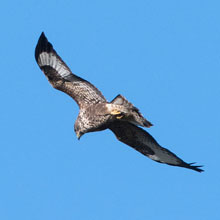 |
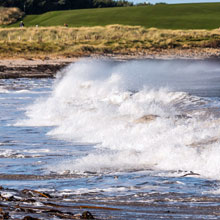 |
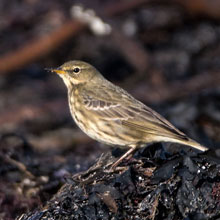 |
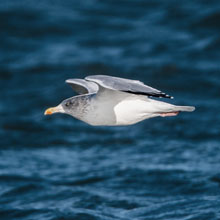 |
The gulls were riding
the breaking waves which every so often were
violent enough to push the birds to flight before they once again
settled in the water. We reckoned that they were picking out
invertebrates that had been swept off the pile of seaweed. I noticed
that more Black-headed Gulls and a few Common Gulls had flown in (see
“Pictures of the Week”, below) to join the flock. A
large
flock of Turnstones then darted onto the scene and settled close to
where we were sitting. Of course a pair of ever-present Pied Wagtails
got in on the act, as did some equally ubiquitous Starlings.
| Black - headed Gull |
Turnstone |
Pied Wagtail |
Juvenile Starling |
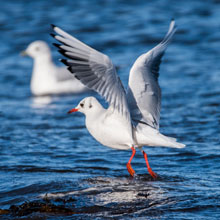 |
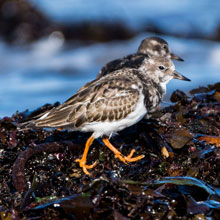 |
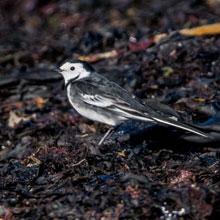 |
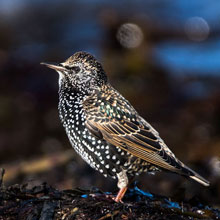 |
The beach was starting
to fill up with dog walkers and well-wrapped
weans so we decided to move the short distance to Barns Ness. On
arrival we could sea a large Oystercatcher flock gathered on the rocks
beyond the wire dump. They were very soon spooked by some of the
walkers coming from the direction of White Sands. We made our way along
the shoreline but all that caught our eyes were a solitary Redshank and
a pair of Carrion Crows that were foraging on the shore. A hundred
metres offshore I could see several Cormorants stubbornly resisting the
rising tide and lashing waves.
| Oystercatchers |
Redshank |
Carrion Crow |
Cormorant |
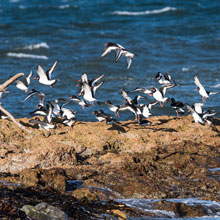 |
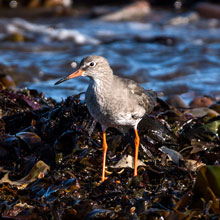 |
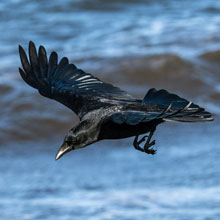 |
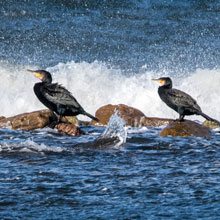 |
Just before we rounded
the lighthouse we passed some very pretty, well-illuminated Mallards
sheltering in a big rock pool.
The Barns Ness
lighthouse must have been hosting some radio event since
it was surrounded by tall shortwave radio aerials. Just a little
further along from there I snapped a half-opened Goat’s
Beard whose
very
long bracts
gave the flower a crown-like appearance. Eventually we reached a gap in
the dunes through which we moved stealthily towards the seashore lest
we spooked any birds there. We needn’t have bothered as the
birds
were well east of there. We walked back onto the path and further east
to the next dune gap and repeated the process. We found that the
situation was very like what we had seen White Sands. There were
Redshank flying past (see “Pictures of the Week”,
below) as
well as the same mix of gulls. There did however see a few Dunlins (a
bird that didn’t show at White Sands). I managed some decent
shots of a passing pair.
A large Turnstone flock
swept in (having been disturbed by walkers
further to the east) (see also “Pictures of the
Week”,
below). The large flock of gulls was riding the swell and waiting for
each wave to flush invertebrates out of the seaweed.
| Turnstone |
|
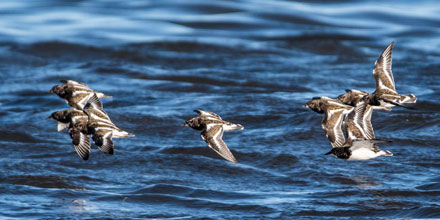 |
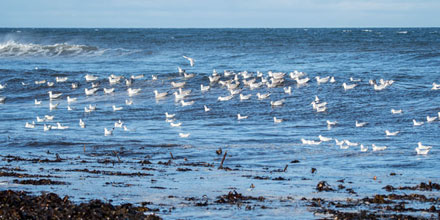 |
We sat on the sandy
beach fairly close to the mass of rotting seaweed.
At our feet we noticed hordes of small invertebrates all frantically
scrambling away from the seaweed. Using my trusty LumixLX5 I captured
images of a few of them. The biggest was a Seaweed Fly, Coelopa
Frigida. The majority
of
the insects we saw were Seaweed Rove Beetles, Cafius
Xantholoma.
Great writhing clumps of them became trapped in the
“pits”
formed by footprints in the sand. A few Sand Millipedes,
Ommatoiulus Sabulosus ,
weaved their way relatively easily through the sandscape. The most
active creatures on the scene were the Sand Hoppers, Talitrus
Saltator .
At any given time many tens of them were hopping tens of centimetres
into the air as they fled from the wave-battered seaweed.
| Fly - Coelopa frigida |
Beetle - Cafius xantholoma |
Sand Millipede |
Sand Hopper |
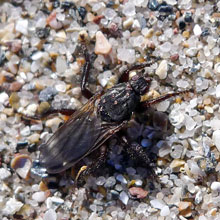 |
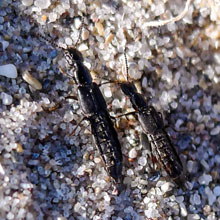 |
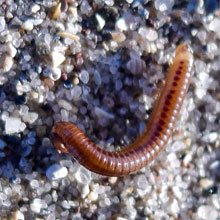 |
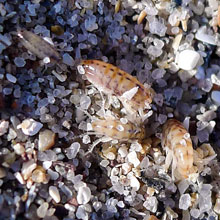 |
We returned back to the
car via the tree-lined southern path. As we
passed the cement works excavations John spotted a Kestrel about 200m
beyond the perimeter wall. With the light coming from behind the bird
it was silhouetted against the shade of the distant hillside. As we
moved along the shrubby path we disturbed a Common Darter dragonfly but
I managed a shot when it settled on some low branches. On the final part
of the path back to the car park as we crossed the derelict caravan
site I spotted a pair of mushrooms nestling in the short grass. I
identified them as Stubble
Rosegills , a
common, well-known mushroom of late summer and early autumn. Our final
capture was of Common
Storksbills
growing on the grass verges at the car park. Like many wildflowers their
tiny blooms are easily overlooked but a closer examination, e.g. taking
a macro photo, is usually rewarding.
| Kestrel |
Dragonfly - Common Darter |
Stubble Rosegill |
Common Storksbill |
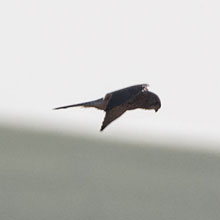 |
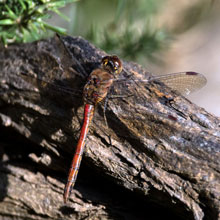 |
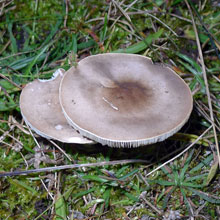 |
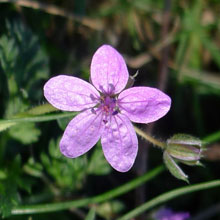 |
It had been a very
pleasant and rewarding trip. The clear, bright light
produced many photo-opportunities that we exploited pretty well. Stars
of the day were probably the invertebrates we found on the east beach
of Barns Ness. It was cream scones again with our teas, rounding off an
enjoyable and interesting outing.
Pictures of the Week:
| Common Buzzard |
Common Gull |
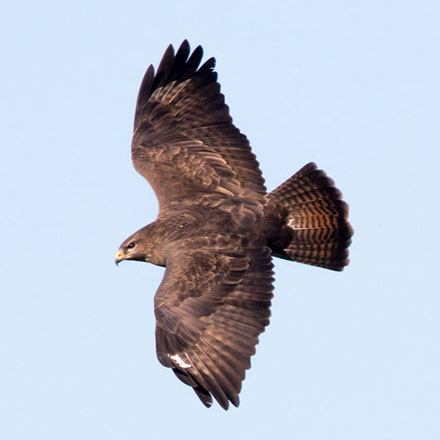 |
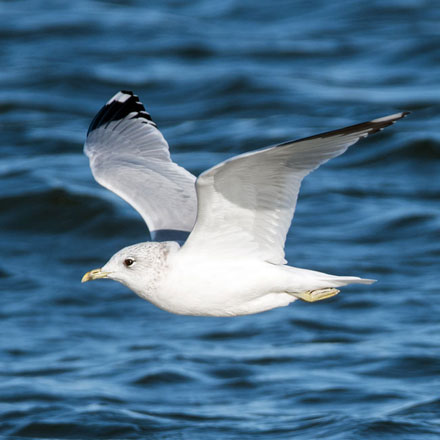 |
| Turnstone |
Redshank |
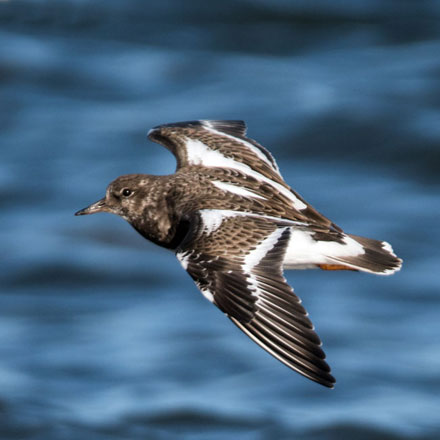 |
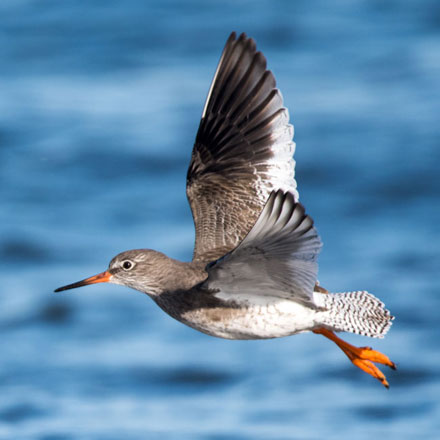 |
20th
October 2019:
Ardmore Point
For the first time in
months the weather prediction for Sunday in West
Central Scotland was for dry sunny weather. Ever since our abortive
attempt to visit there (when my car broke down on the way there)
I’d been wanting to visit Ardmore
Point
on the Clyde Estuary, just west of Dumbarton. So after a breakfast in
Dumbarton Morrisons (8/10: nice meal but slow service and overdone
bacon) we found ourselves strolling out along the south side of the
promontory towards its rocky point. The tide was low and the sun was in
our eyes but the wind was gentle and the only sounds were of the birds
and blathering walkers (of which there were many).
A pair of silhouetted
horse riders were far out on the sands. I noticed that there were still
quite a few Bindweed flowers in bloom, and also very
many berries such as those on the Holly
bushes, clustered within their waxy spiky leaves, and Blackberry, its
berries red and needing yet more mild weather to ripen to black before
the inevitable frosts of late Autumn.
|
Bindweed T.B.C |
Holly |
Bramble Fruit |
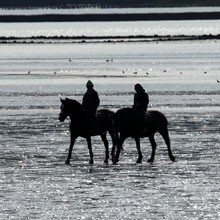 |
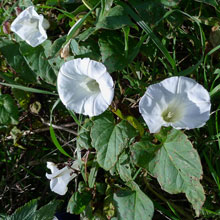 |
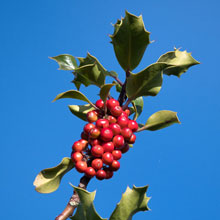 |
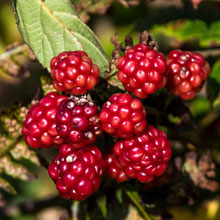 |
I snapped a delicate,
beautiful Marmalade
hoverfly
as it sat on a yellow flower of Wild Radish. And draped on the fences we
also noticed large patches of flowering Ivy around which a variety of
insects were feeding. The dronefly Eristalis Pertinax was well
represented. A lively, pollen covered Common Wasp dashed between
flowers. A Bluebottle,
Calliphora Vicina, (or possibly Calliphora Vomitoria) rested on the
foliage and soaked up the warm sunshine before carrying on its busy
mission.
| Marmalade Hoverfly |
Hoverfly - Eristalis pertinax |
Common Wasp |
Fly - Calliphora vicina |
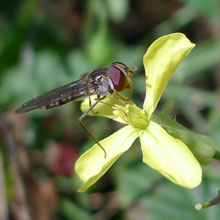 |
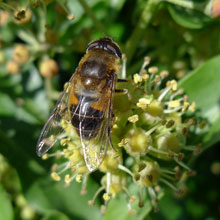 |
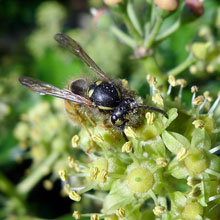 |
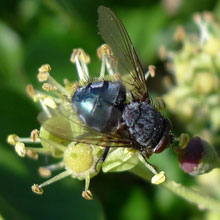 |
I photographed a
well-lit Red Campion, surely another sign of the
milder conditions experience at Ardmore compared to sites further east.
A pair of small birds fluttered past us into a bush. Eventually they
appeared on its outer branches. One was a Dunnock and the other a bonny
wee Robin, each lit nicely by the low Autumn sun. We were just about to
move on when I heard a third bird. It was a Greenfinch which I could
just get a clear view through the withering leaves (see
“Pictures
of the Week”, below). Once again we were about to move on
when a
second Greenfinch, a female, popped out of the bush and into view.
| Red Campion |
Dunnock |
Robin |
Female Greenfinch |
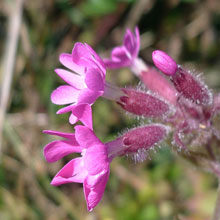 |
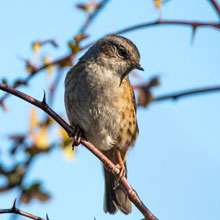 |
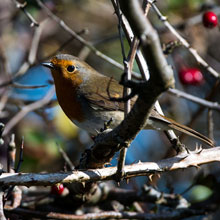 |
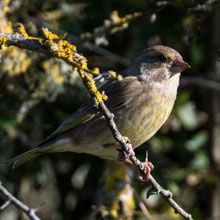 |
A half dozen Canada
Geese
flew north past us somewhat silhouetted by the sunlight. We had seen
them earlier swimming pretty far out on the Clyde, too far for a decent
shot. Also backlit were 5 Redshanks feeding on the shore.
| Canada Goose |
Redshank |
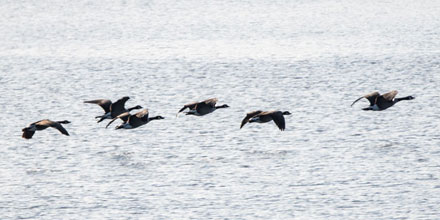 |
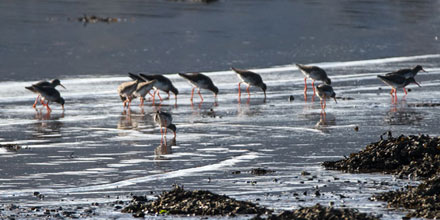 |
A trio of Red-breasted
Mergansers followed the same line as the Geese.
I noticed the contrail of a high-flying aeroplane flying past the waning
gibbous Moon. Also catching my eye were another couple of late-flowering
plants caught my eye. The first was Yarrow , Achillea Millefolium, named after
Achilles, the Greek hero who is reputed to have used the plant to heal
battlefield wounds.
| Red - breasted Merganser |
|
Yarrow |
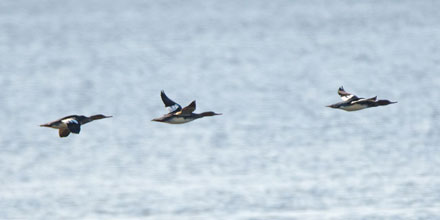 |
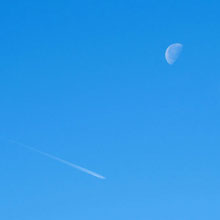 |
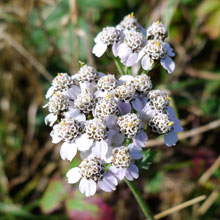 |
The other flower nestling
in the long grass close to the shore was purple Devil’s
Bit Scabious,
pin-cushion-like with its protruding anthers. A Curlew flew past close
in heading north round the Point. We were distracted by a commotion
happening in the sky above the centre of the peninsula. About 100 Jackdaws
had taken to the air, exactly why I don’t know. We did notice
though that there were four Buzzard flying in the same vicinity, but
usually Corvids mob Buzzards but these were not flying towards them.
| Devil's Bit Scabious |
Curlew |
Jackdaw |
Common Buzzard |
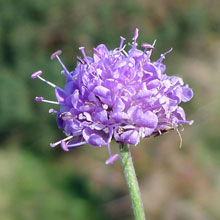 |
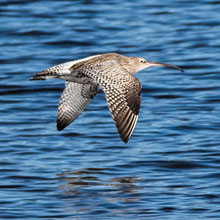 |
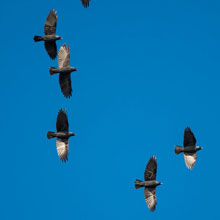 |
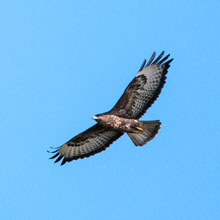 |
As we trudged round the
very wet footpath I came across a large
dandelion-type flower. It think it was probably a stunted growth Marsh
Thistle. As I photographed it I was serenaded by a beautiful Robin
sitting on a Wild Rose bush (see “Pictures of the
Week”,
below). Fed up with plodding along the boggy path we decided it might
be easier to try picking our way across the rocky shoreline. As we
crossed onto the shore we passed some flowering Sea
Asters .
We carefully negotiated our path across difficult terrain which was
strewn with hazards that we’d have skipped across when we
were
younger, but now in the autumn of our lives we had to make sure each
foothold was sure and would not lead to a crippling slip. This was
quite difficult when we were met by the sight of a Shag with a mouthful
of fish, or a young, uncertain Cormorant that surfaced not far from
shore.
| Marsh Sow Thistle |
Sea Aster |
Shag |
Cormorant |
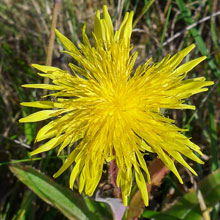 |
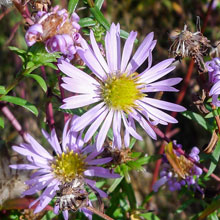 |
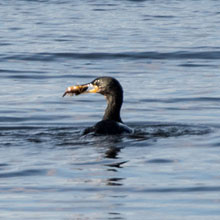 |
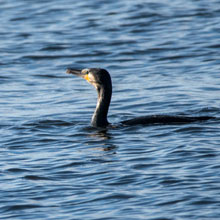 |
We passed a large
boulder upon which a pair of Herring Gulls were
resting. Near them on the seafacing edge of the boulder a Mallard pair
sat snoozing until the drake heard my approach. I left them in peace.
Almost hidden by the long grass on the edge of the shore I noticed what
I think was very late-flowering and delicate-looking Lesser Stitchwort
(or it may have been Marsh Chickweed). We rounded the Point and reached
the North Bay and parked ourselves on our stools to survey the
panorama. First to show were a flock of Oystercatchers flying out of the
Bay heading towards Helensburgh. Next, what seemed like a very light
coloured Rock Pipit (see “Pictures of the Week”,
below)
paid us a visit. Its relatively light colouring and the prominent dash
above its eyes (supercilium) and other features lead me to conclude it
was a Scandinavian
Rock Pipit
(Anthus petrosus littoralis).
| Herring Gull |
Mallard |
Lesser Stitchwort |
Oystercatcher |
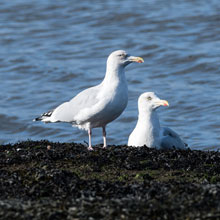 |
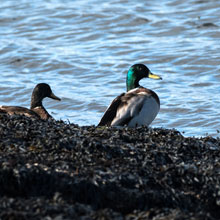 |
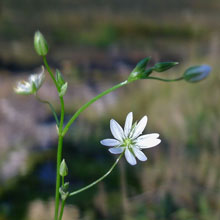 |
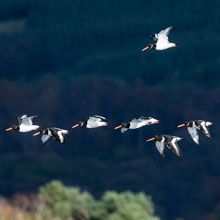 |
We walked along the
north side of the peninsula and surveyed the birds
feeding on the exposed sands of the Bay. Just below us on the shore a
very well-lit Curlew was foraging for invertebrates (see
“Pictures of the Week”, below). There were a few
more
Curlews a lot further out but they were vastly outnumbered by the
ubiquitous Oystercatchers. Shelducks too were well represented.
As we reached the car we
noted that we had been treated to unbroken
sunshine throughout the walk, a splendid treat given the miserable
light we’d experienced in recent weeks. Our teas and cake -
delicious creamed chocolate muffins - rounded off a very successful and
enjoyable trip.
Pictures of the Week:
| Greenfinch |
Robin |
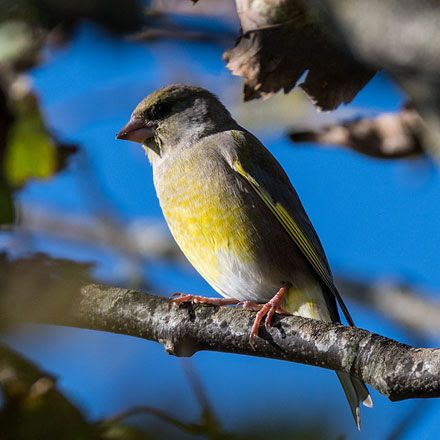 |
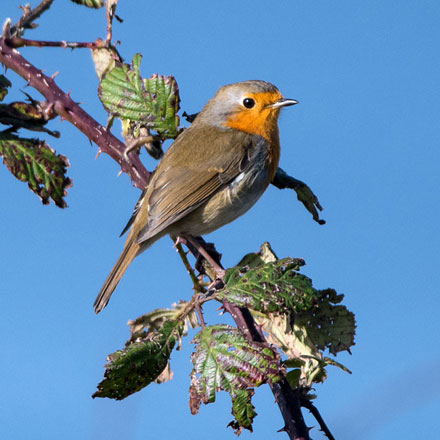 |
| Scandinavian Rock Pipit |
Curlew |
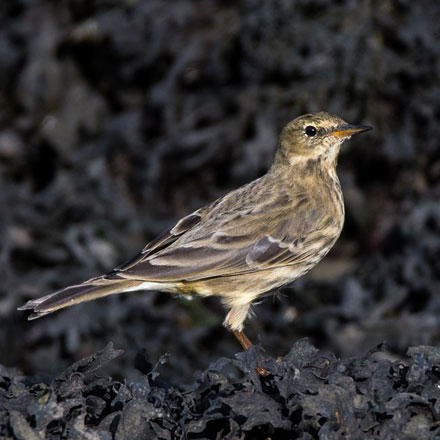 |
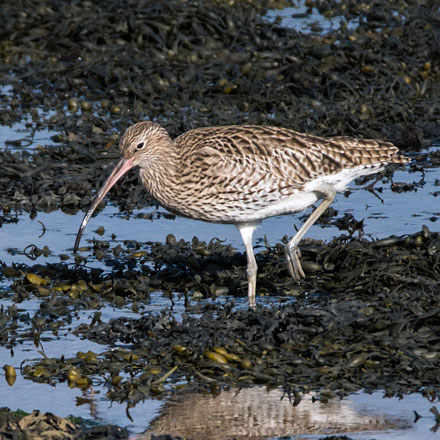 |
13th October 2019:
Stevenston, Saltcoats
and Irvine Harbour
Deja vu! Sunny Friday
and Saturday (and Monday) but grey Sunday - very
frustrating. There were slightly better conditions predicted for the
west so I decided that Stevenston, Saltcoats and Irvine were worth a
visit (even although we’d been there fairly recently). We
love
Stevenston Morrisons so after one of their excellent breakfasts we
headed for Stevenston Point which was at least dry when we arrived. I
snapped one of the many Common Gulls that were feeding on playing
fields. They were doing their wee tap dances. Apparently the worms think
the rain drops are landing so they move to the surface to avoid
drowning. On the rocky top of the Point we could see a large
flock
of winter plumage Knot. A few Herring Gulls circled overhead and
some Shag were active in and out of the water.
| Common Gull |
Knot |
Herring Gull |
Shag |
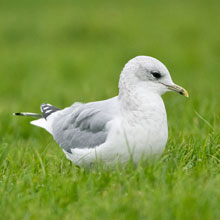 |
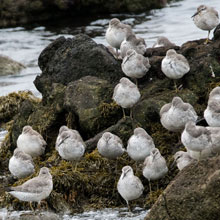 |
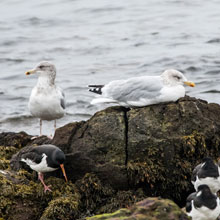 |
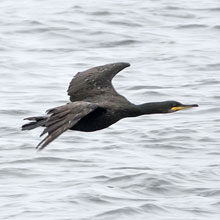 |
A few Oystercatchers and
Herring Gulls mingled with the Knot. As the
tide came in the Knot found drier rocks to perch on. A large Cormorant
made a close pass just south of the Point (see “Pictures of
the
Week”, below).
| Oystercatcher |
2nd Cycle Herring Gull |
Knot |
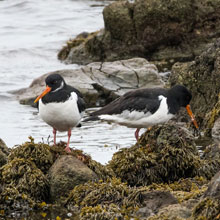 |
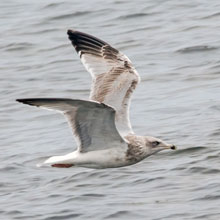 |
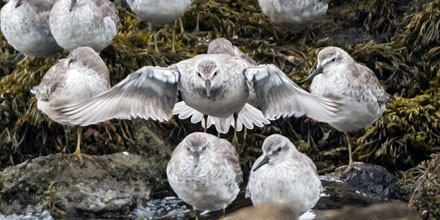 |
About 800m offshore long
line of 19 Geese, probably Pinkfoots, flew south. Why weren’t
they flying an a V-formation?
After about an hour we
decided to move to the Ardeer
Quarry
reserve to see what we could find. Initially we were disappointed to find
the main pond empty of birds, apart from some distant Mute Swans that
were being fed by excited children. A Magpie checked us out before
taking to the trees. John spotted a passing Sparrowhawk
that only showed for about 10 seconds, although I managed a fair record
shot. As we passed along the Hawthorn-lined footpath we became
surrounded by a flock of small birds - Long-tailed, Great and Blue Tits
and a couple of Goldcrests. Frustratingly, I only managed a record shot
of a Blue Tit. The birds weren’t pausing much to get their
picture taken, and when they did I found it very tricky to focus on
them due to the poor light and the many small branches that interrupted
my line of sight. We came upon a community
orchard of Apple trees
that were loaded with fruit. John had a nibble on one but found it was
a bit tart.
| Magpie |
Sparrowhawk |
Blue Tit |
Sour Aipples |
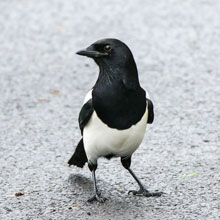 |
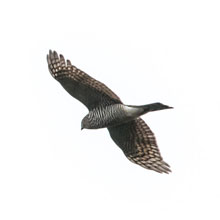 |
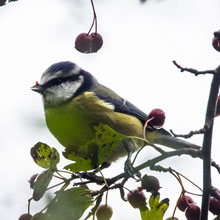 |
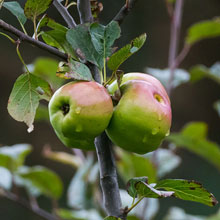 |
We curtailed our visit
to the Park due to the time we had spent
chatting with the very friendly walkers of Stevenston (who are just as
interested in nature as we are). We moved north to Saltcoats Harbour
where there are always Herring Gulls on and around the sea walls on the
look out for discarded chips, like the juvenile we passed. John spotted
a light-coloured Guillimot at the Harbour mouth. We plodded round there
and found it getting to grips with what looked like an Eel.
With a closer view I
realised that it was a Black
Guillemot
in winter plumage (see also “Pictures of the Week”,
below).
A mile offshore we could see a cargo ship which, after some
investigation we identified as the “Ayress”, a Timberlink Service ship that transports
timber from Argyll forests to processing plants in Ayrshire.
| 1st Cycle Herring Gull |
Black Guillemot |
Shag |
Ayress |
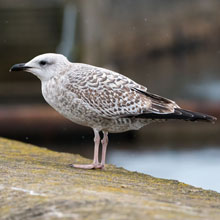 |
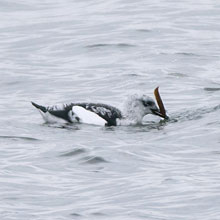 |
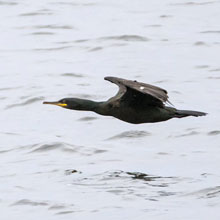 |
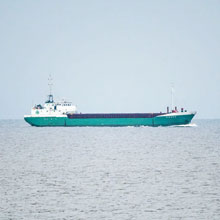 |
We walked round to the
north side of the harbour where I got some nice
shots of a Robin and a Rock Pipit that were darting about on the rocks
(see also “Pictures of the Week”, below). Most of
the wild
flowers that decorated the shore had died back and only patches of
Scentless Mayweed remained. As I photographed the Mayweed a Red-breasted
Merganser flew
speedily into the harbour.
| Robin |
Rock Pipit |
Scentless Mayweed |
Red - breasted Merganser |
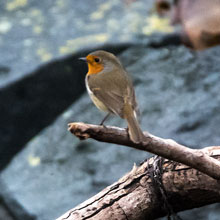 |
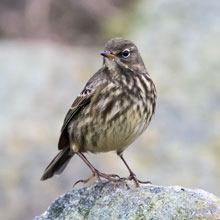 |
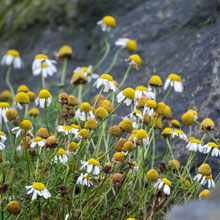 |
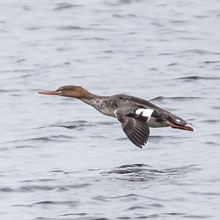 |
On the exposed rock a
bit nearer the harbour mouth we came across a
small flock of roosting Redshanks accompanied by some more active
Turnstones.
| Redshank |
Turnstone |
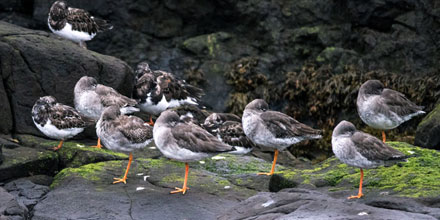 |
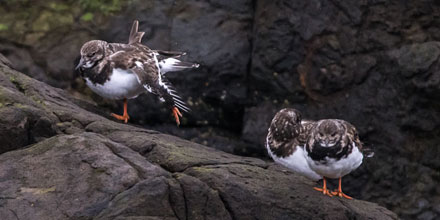 |
A solitary young Ringed
Plover appeared at the highest point on the
rocks. The rest of its family were probably out of sight behind the
rocks. John then drew my attention to a Grey Seal that had surfaced
beyond the harbour mouth. I just managed a shot before it it
disappeared below the waves. As the rain came on in earnest a pair of
Cormorants stood on rocks just north of the harbour. The one shown
below is a juvenile. We moved hastily back to the shelter of the car,
passing the Merganser we’d seen earlier which was now
paddling
near the harbour wall.
| Ringed Plover |
Grey Seal |
Juvenile Cormorant |
Red - breasted Merganser |
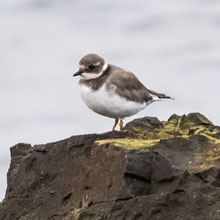 |
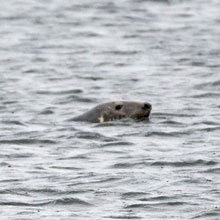 |
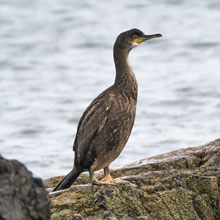 |
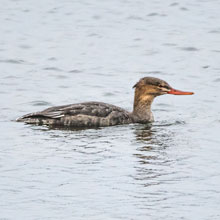 |
Our final location was
Irvine Harbour. An annoying, steady drizzle was
falling there but we decided to move down to the mouth of the River
Irvine to see what we could discover. Our first sighting was of a family
of Mute Swans that were feeding near the Pilots
House.
Two adults and a pair of near-mature cygnets were grazing on seaweed.
Watching their activities was a 2nd year Herring Gull, ready to swoop
down should a feeding opportunity present itself. As we made our way
out to the harbour mouth viewing point a female Pied Wagtail scurried
along the path in front of us before fleeing along the beach.
| Mute Swan |
Juvenile Mute Swan |
1st Cycle Herring Gull |
Female Pied Wagtail |
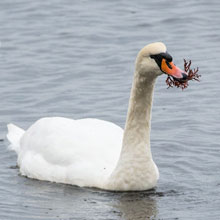 |
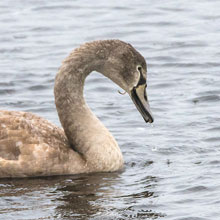 |
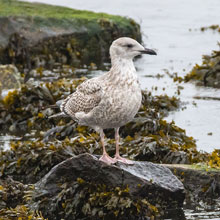 |
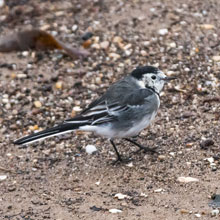 |
Just as we neared the
viewing point a Razorbill surfaced about 30m to
the south. It made a series of dives before moving out of sight. Very
soon afterwards a large flock of Turnstones
crossed the river and landed at the very end of the walkway. I was able
to get some fairly close shots of some of them as they flew in and
foraged on the water’s edge (see also “Pictures of
the
Week”, below). Our last capture was of another Pied Wagtail,
a
juvenile male, picking its way along the sandy shore.
As can be gauged from
the number of observations recorded above, we had
rather a successful outing, in spite of the dull, damp
conditions. Our teas were worthy of special mention. John had bought a
pair of cream scones that were absolutely delicious. I’ll ask
John to buy more for next week.
Pictures of the Week:
| Cormorant |
Black Guillemot |
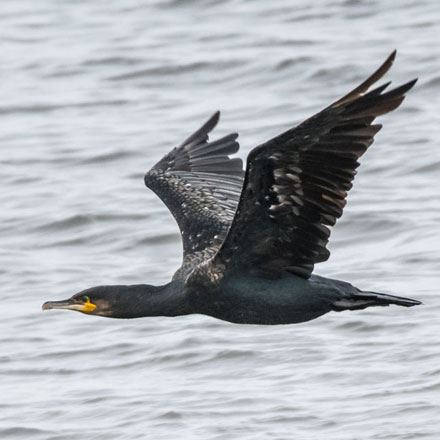 |
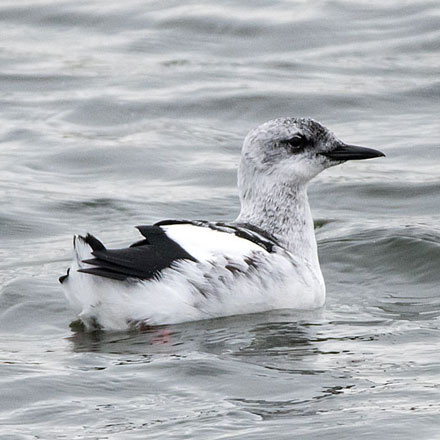 |
| Rock Pipit |
Turnstone |
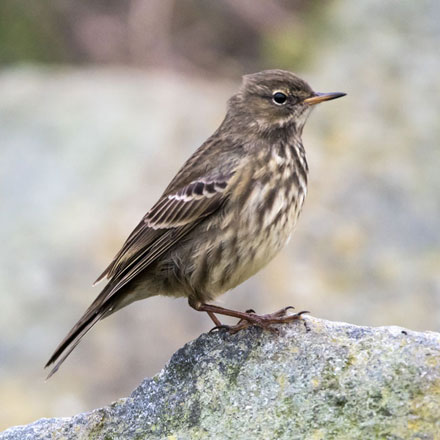 |
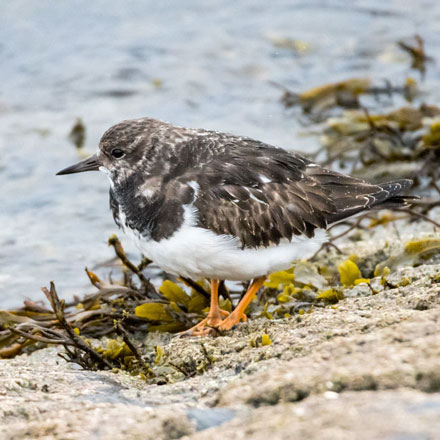 |
6th October 2019:
Doonfoot
The weather predicted
for Sunday was not encouraging - persistent rain
with little or no sunshine. I noticed, though, that the Ayrshire Coast
would be dry by early afternoon. Having visited Stevenston, Troon and
Irvine in the previous couple of weeks, we decided that Doonfoot on the
south of Ayr was the destination we’d give a go. So after a
quick
breakfast in rainy Kilmarnock ASDA (9.5/10: excellent) we found ourself
surveying the swollen waters at the mouth of the River Doon. We
immediately found several gatherings of very flighty Teal, as well as a
large flock of Mallards sheltering on the grassy banks. We crossed the
metal footbridge and planked ourself at the edge of the rocky shore to
view the birds there. A few Stonechats
were posing on top of the vegetation (also see “Pictures of
the
Week”, below). I also spotted some late-flowering Red
Deadnettle by
the sea wall.
| Teal |
Mallard |
Stonechat |
Red Deadnettle |
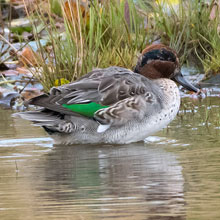 |
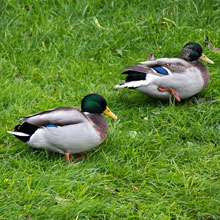 |
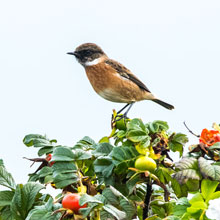 |
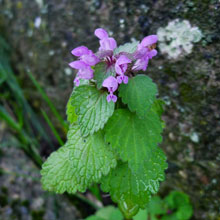 |
The Doon river mouth was
lively with various birds. A male Pied Wagtail
chirped briefly onto the sands in front of us before flying across the
river after other wagtails. Starlings, Teal and Cormorant also made
brief appearances.
| Pied Wagtail |
Starling |
Female Teal |
Cormorant |
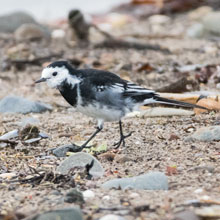 |
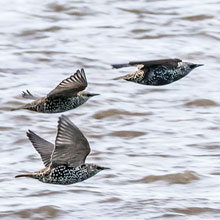 |
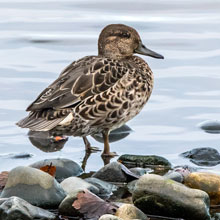 |
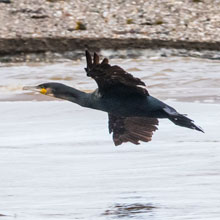 |
From the thick, damp
dune vegetation we heard the tweets of several
small birds. Stonechat, Greenfinch and Robin (see “Pictures of
the
Week”, below) braved high positions on a Wild Rose bush. At
the
waters edge some Turnstones were
foraging, doing as their name suggests. A flock of Lapwings glided past
and landed on a shallow area in the river mouth. An impressive flyby of Teal
brightened the otherwise dim
panorama.
A bold Carrion Crow
picked its way through seaweed scattered on the
rocky shore while the Turnstones took flight as a dog moved past.
| Carrion Crow |
Turnstone |
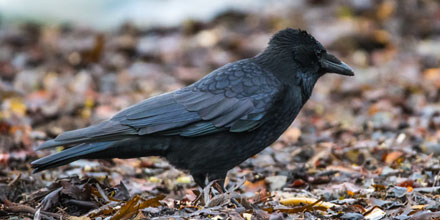 |
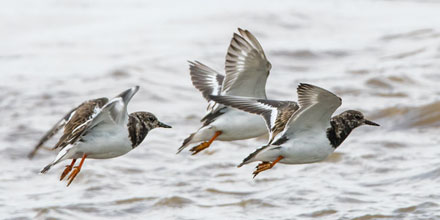 |
A Black-headed Gull
passed overhead before joining a large gull flock
that also included Herring and Common Gulls. We decided to relocate a
mile south to Greenan Shore. On our way back to the car park we noticed
many Snails active on the sea wall. They were reacting to the very damp
conditions. I photographed three species - Garden
Snail(see
“Pictures of the Week”, below) and White-lipped and Dark-lipped snails. Unfortunately many Snails fell foul
of pedestrians and cyclists.
| Black - headed Gull |
Herring Gull |
Brown - lipped Snail |
White - lipped Snail |
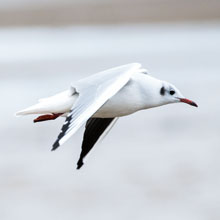 |
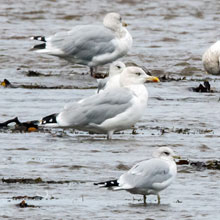 |
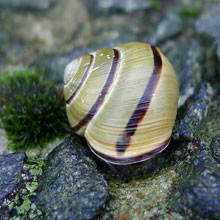 |
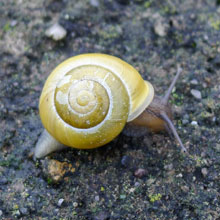 |
After parking in the
Greenan Shore car park we started our usual
circuit around the castle ruin. As we carefully moved along the damp
overgrown path along the edge of the dunes we noticed a Dunnock posing
on a small bush. As we paused to snap it I caught a glimpse of a
red-capped mushroom - a Dune
Waxcap .
Nearby
we passed raindrop-covered Meadow
Cranesbill
flowers, still lovely even in dim light. John drew my attention to a Black
Slug
struggling
over the wet sandy grass.
| Dunnock |
Dune Waxcap |
Meadow Cranesbill |
Black Slug |
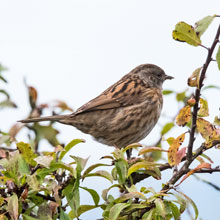 |
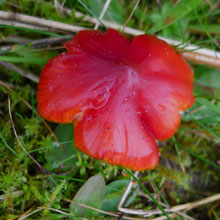 |
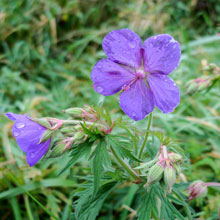 |
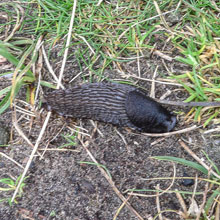 |
We passed below the
castle and John spotted a Rock Pipit on the steep,
poorly-lit rock face. On the sands immediately to the south of the
castle I got pictures of a female Pied Wagtail, one of a flock of five,
mainly juveniles. A strangely-marked Jackdaw got very close as it
examined the soggy seaweed for titbits. We then started our return
journey by moving north along the field adjacent to the beach. I managed
a quick shot of a shy Yellowhammer that had been calling high on top
of Hawthorn bushes.
| Rock Pipit |
Pied Wagtail |
Jackdaw |
Yellowhammer |
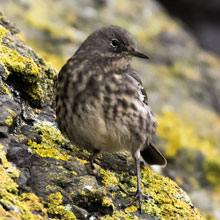 |
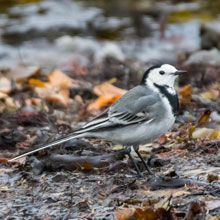 |
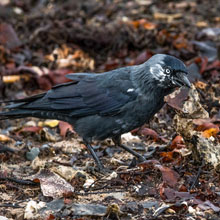 |
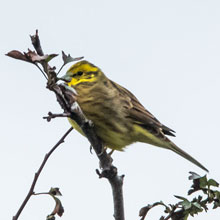 |
We next ascended the
slope to the Site of Greenan Castle. Below is the view to the south.
One of the many Carrion
Crows that occupy the castle site was perched
on top of a Hawthorn bush pecking at something it had caught, probably
a large whelk shell. On the edge of the field to the east of the castle
I came across some Field
Woundwort,
a first for us. We had seen and heard Goldfinches throughout our walk
around the castle, however they managed to evade capture by my camera.
No such difficulties were experienced in photographing the House Sparrows
we saw. We watched them as they waited in the hedgerow for us to pass.
Our final sighting of the trip was arguably our best. We could hear high
pitched bird calls coming from the hawthorns. I recognised these as the
calls of Goldcrests .
After a short wait a pair of Goldcrests came into view. Although they
were in continuous motion, and so were difficult to photograph, I did
manage a couple of reasonable shots, albeit in very dim conditions.
| Carrion Crow |
Field Woundwort |
House Sparrow |
Goldcrest |
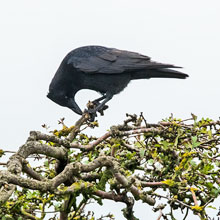 |
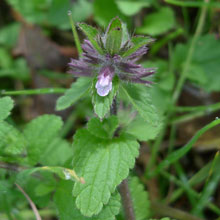 |
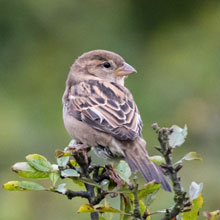 |
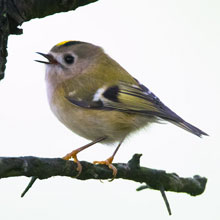 |
On a day that might have
been a complete washout we managed to record a
very satisfying collection of sightings. My personal favourite was the
Goldcrest, although a newby is always welcome, so we were pleased with
the Field Woundwort. Of course we celebrated in our normal fashion by
each downing a pair of chocolate cream eclairs with strong tea. The
best part of the day!
| Stonechat |
Greenfinch |
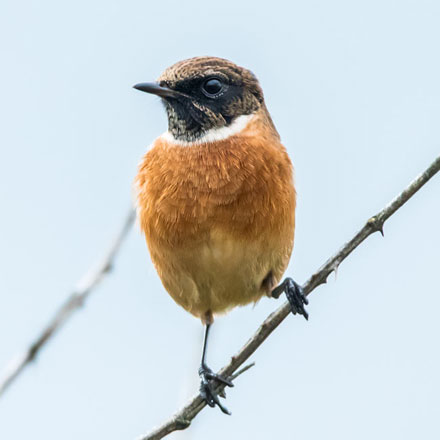 |
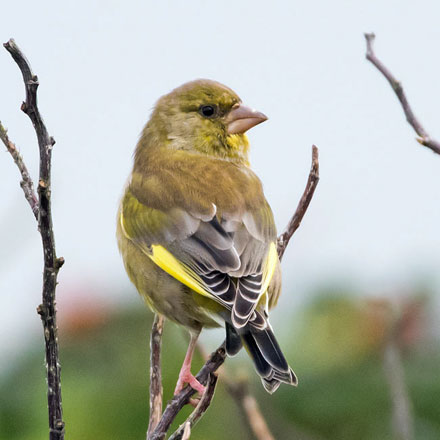 |
| Robin |
Garden Snail |
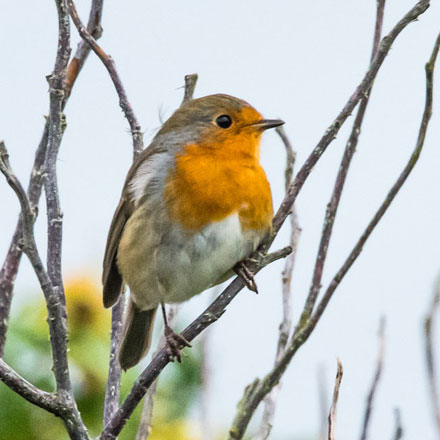 |
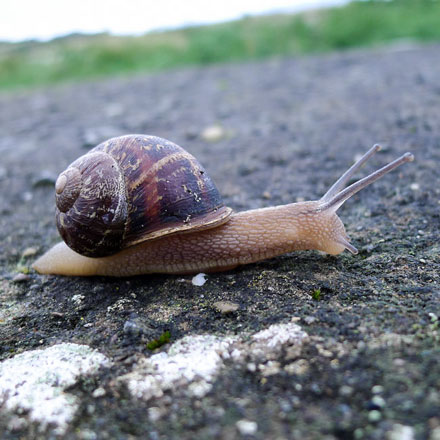 |
Highlights - October 2019
We present a gallery of my favourite pictures taken during October
2019. They are not listed in the order they have been taken, but
according to a series of themes. I’ve kept commentary to a
minimum, preferring to let each picture talk for itself.
INVERTEBRATES
| Comma Butterfly |
Hoverfly
- Eristalis arbustrum. |
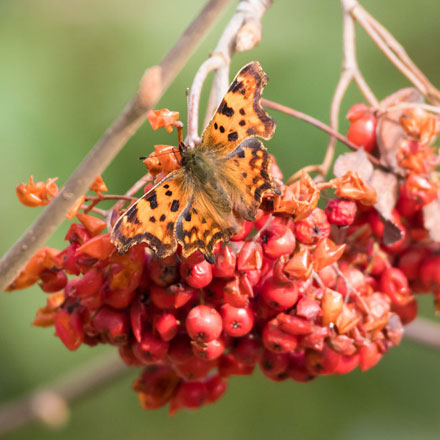 |
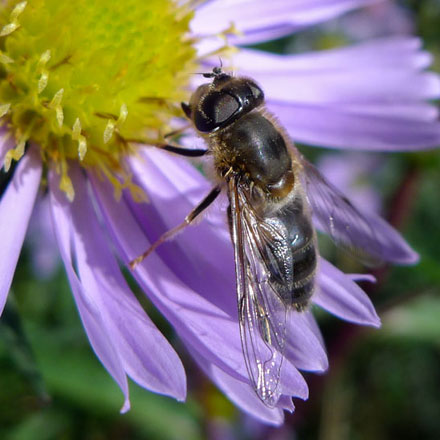 |
| Fly - Lucilia caesar. |
Hoverfly - Marmalade |
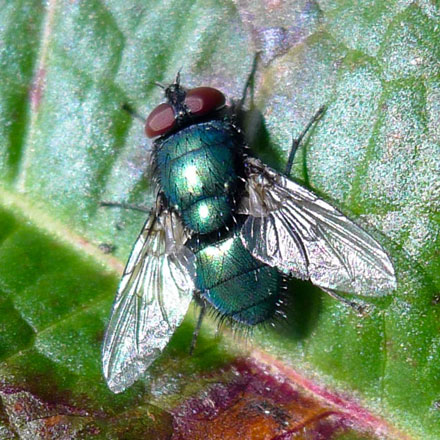 |
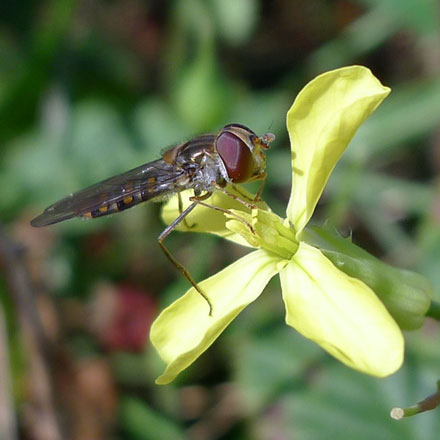 |
WINGS
| Cormorant |
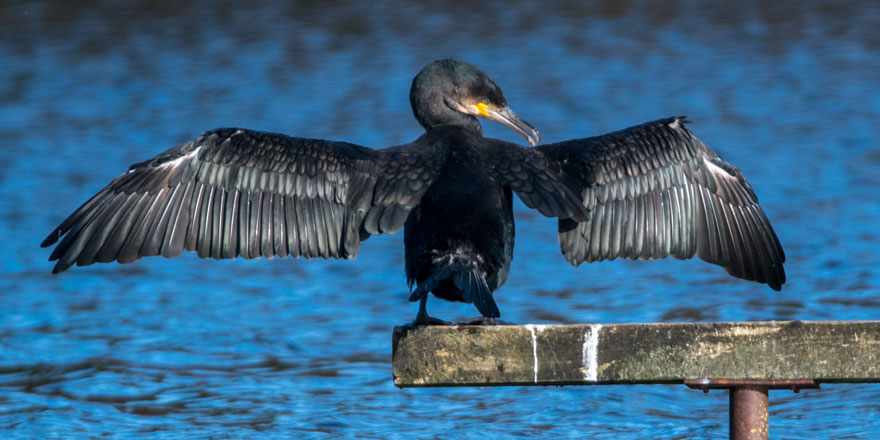 |
| Feral Pigeon |
Common Buzzard |
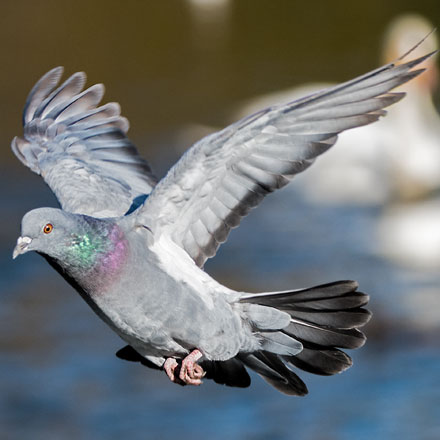 |
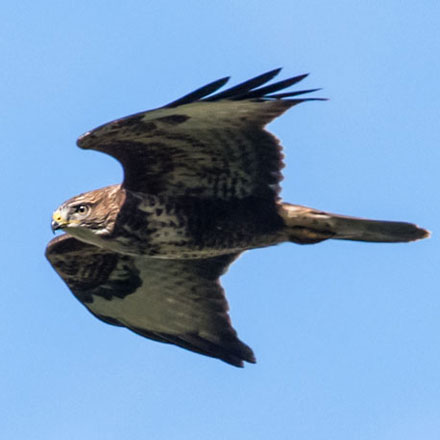 |
PORTRAIT
| Greylag Goose |
Whooper Swan |
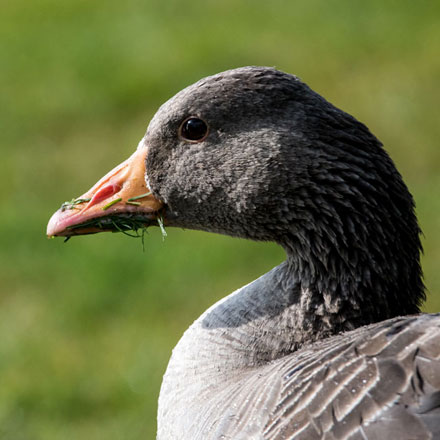 |
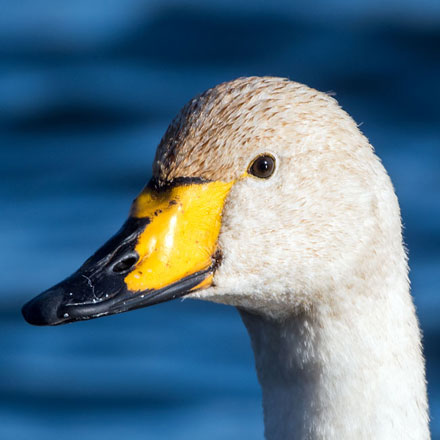 |
| Lapwing |
Female Goosander |
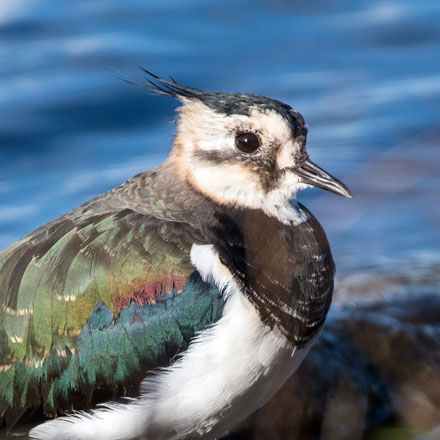 |
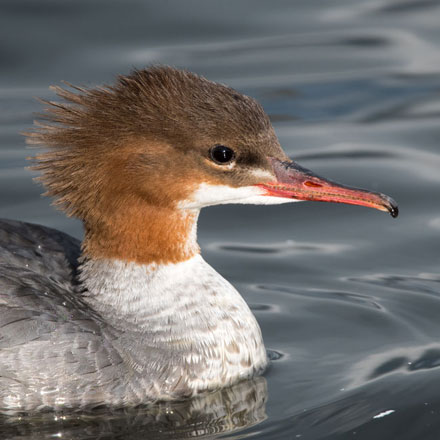 |
BERRIES
| Blue Tit |
Robin |
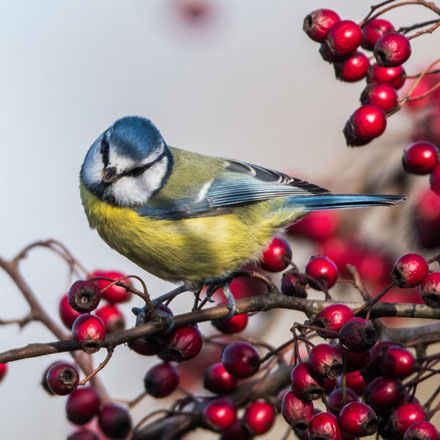 |
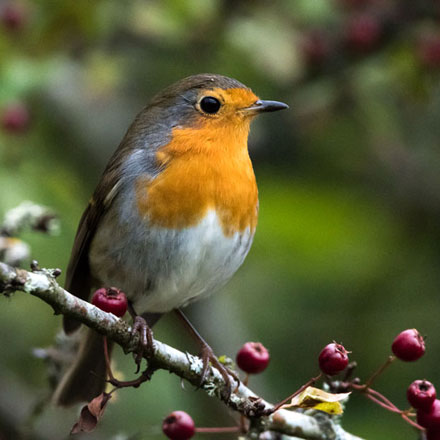 |
WATER
| Female Mallard |
Whooper Swan |
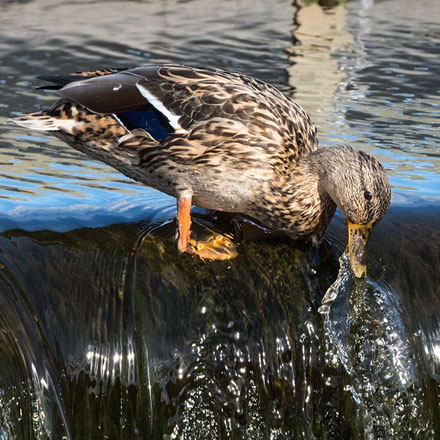 |
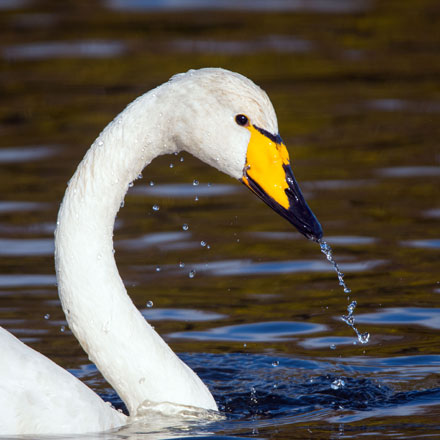 |
| Drake Mallard... |
|
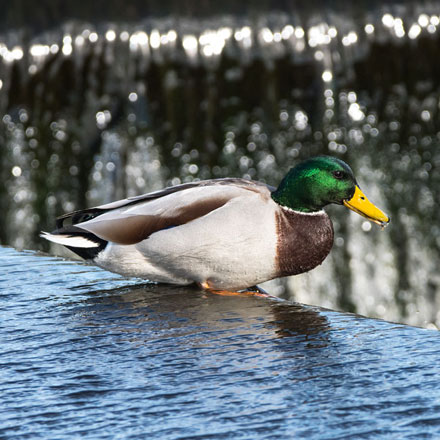 |
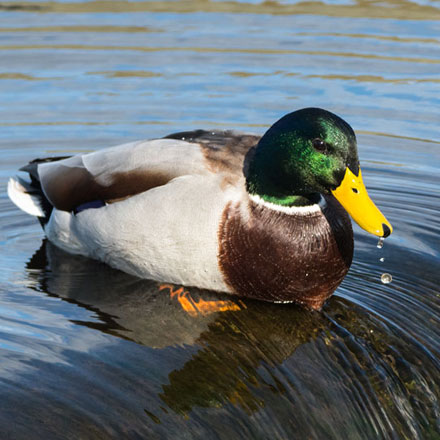 |
FLOWERS
| Michaelmas Daisy |
Ivy - leaved Toadflax |
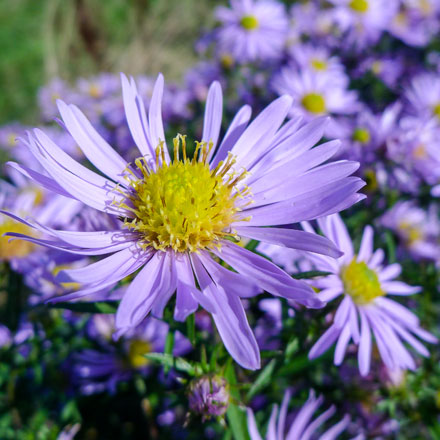 |
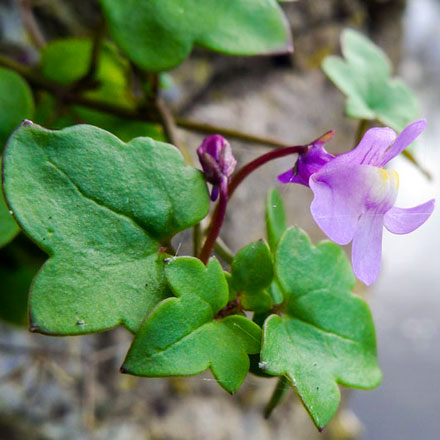 |
| Monbretia |
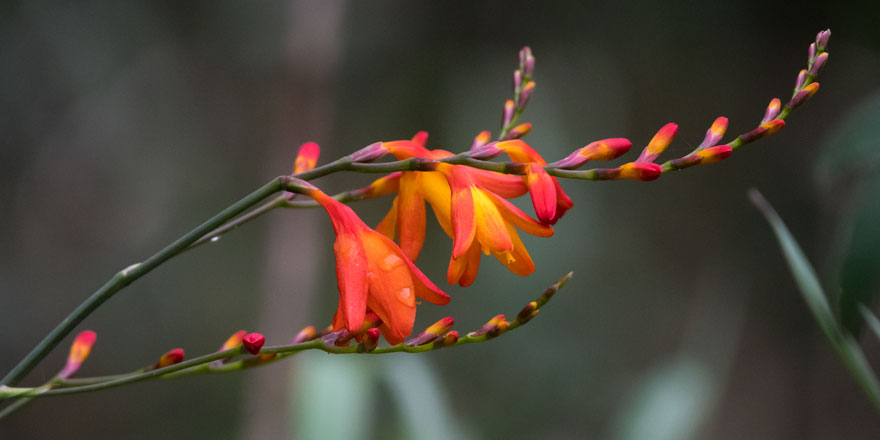 |
LIGHT and SHADE
| Grey Heron |
Moorhen |
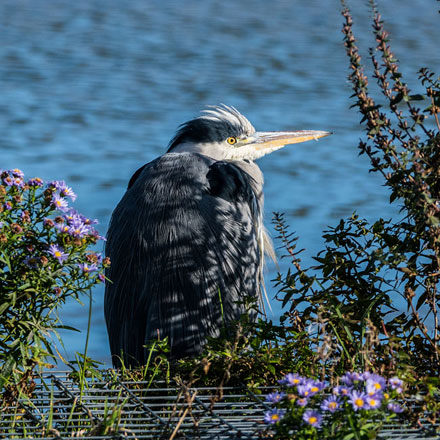 |
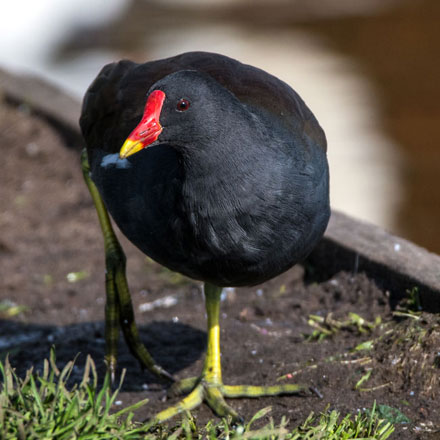 |
| Tufted Duck |
Grey Wagtail |
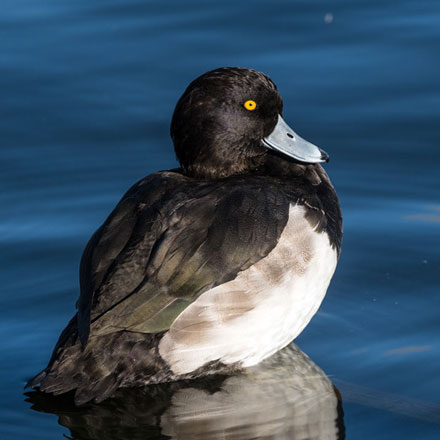 |
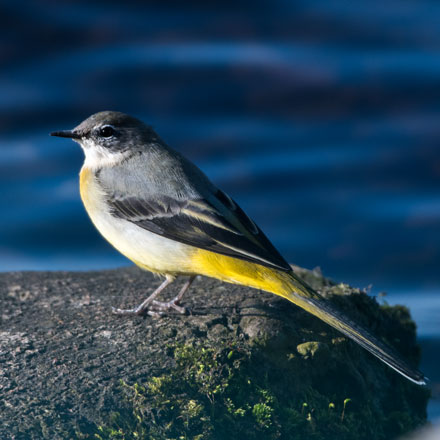 |
FURRY
| Grey |
Squirrel |
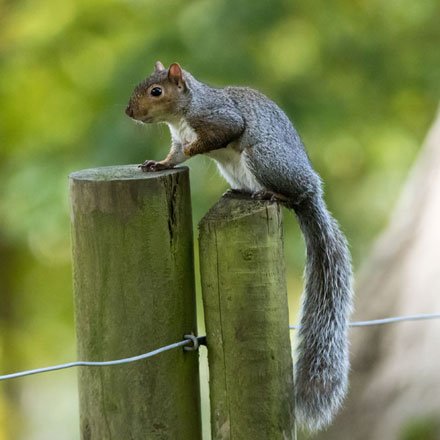 |
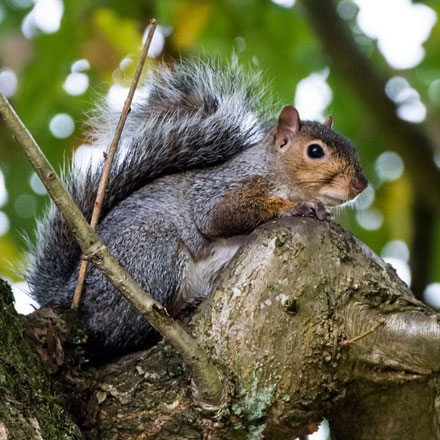 |
| Grey Squirrel |
Carrion Crow with lunch |
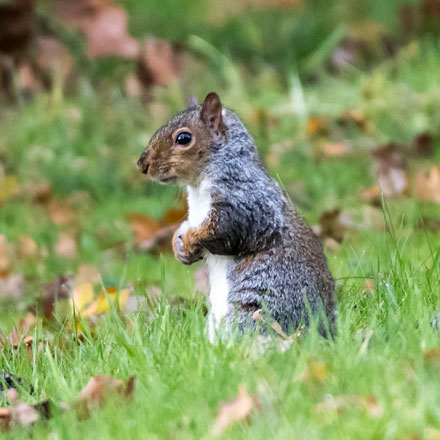 |
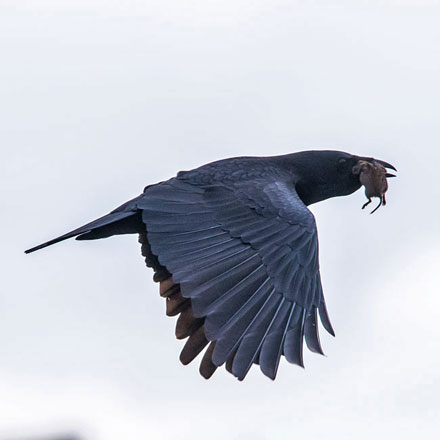 |
FUNGI
| Glistening Inkcap |
Shaggy Inkcap |
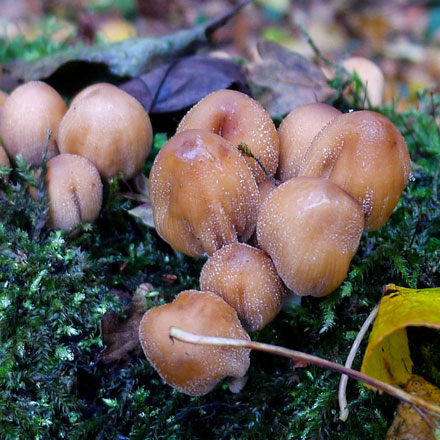 |
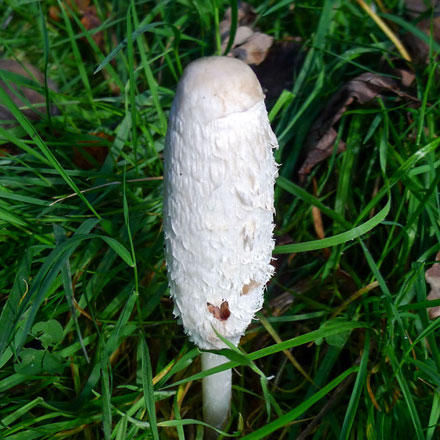 |
| Blushing Bracket |
Trooping Funnel |
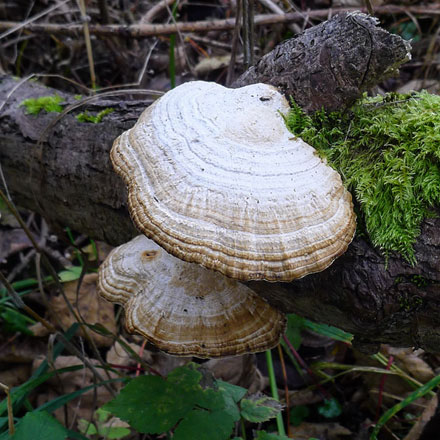 |
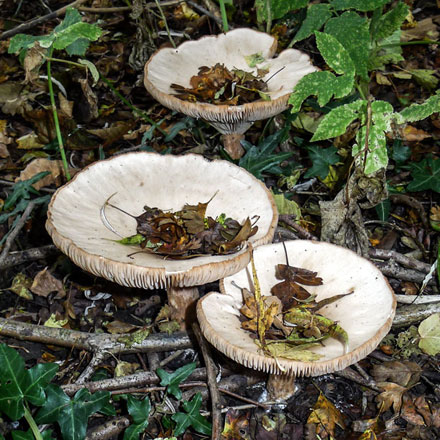 |
Back To Top
|

